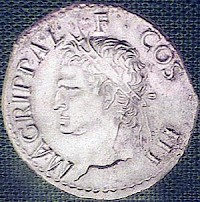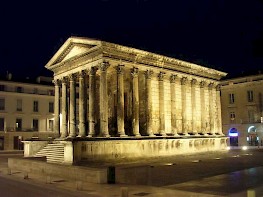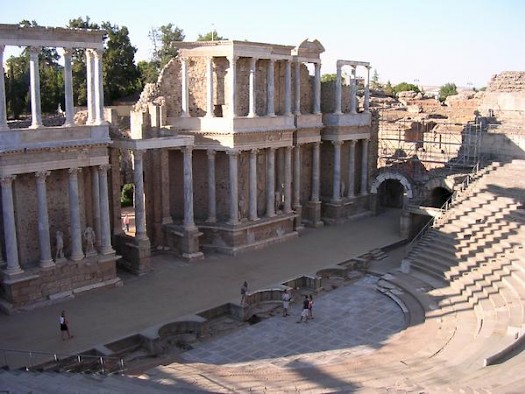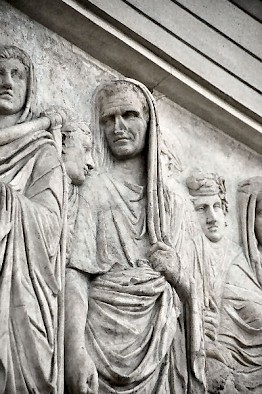M. Vipsanius Agrippa (3)
Marcus Vipsanius Agrippa (64/63-12 BCE): Roman politician, friend of the emperor Augustus.

Octavian conquered Egypt in 30, returned to Italy in 29, celebrated a triumph, and closed the "Gate of Janus". He gave the highest honors to his friend Agrippa. One of these was a marriage with Octavian's niece Claudia Marcella. (What had become of Caecilia Attica, Agrippa's first wife, is unknown.) Another honor was the right to use an azure banner, to remind the people that Agrippa had been the victor at Actium. On a more practical level, he received country estates in Egypt.
In 28, the two men were both consul. A second consulship was unusual, and that Octavian wanted to share the supreme office in the republic with Agrippa was a rare and important distinction. The two men accepted censorial powers and conducted a census, which means that they counted the Roman citizens and tried to find out how many people had to pay taxes. They also revised the roll of the Senate - not as a political purge, but to restore the honor of this political body. Of the 1,000 members, 50 retired voluntarily, and 150 were dismissed. Many opponents of the new regime remained as members of the Senate: Octavian knew when to exercise the virtues of moderation, clemency, and reconciliation.

Octavian and Agrippa remained in office in 27. It is as if Octavian wanted the Romans to believe that he and Agrippa were partners: a clever way to prevent them from thinking that Rome had become a monarchy. Yet, this construction would in the end be impossible, because the repeated consulships were just as unconstitutional as the kingship. Therefore, Octavian announced that he wanted to restore the traditional republic and laid down his extraordinary, triumviral powers.
This was of course impossible, because it would mean civil war. Therefore, the senators protested - this has been carefully orchestrated - and conferred upon Octavian the governorship of those provinces that were still unsettled. In other words, Octavian became commander of almost every Roman legion. He also received a special title, Augustus, which can be translated as "majestic" or "venerable". For the time being, he also kept the consulship - for several years, until 23.
A building program on the Field of Mars stressed the restoration of the republic, and also showed that the two men continued to cooperate. In the north of the building zone, Augustus built his Mausoleum, and facing it -although separated by some distance- Agrippa built the Pantheon, a round temple that appears to have played a role in the cult of the genius (protective deity) of Augustus. The two monuments were connected by a wide alley. (The Pantheon that can now be visited in Rome is a later reconstruction by the emperor Hadrian, but still bears the inscription M. Agrippa L.f. cos tertium fecit ("Marcus Agrippa, son of Lucius, built this when he was consul for the third time").
This part of the Field of Mars would from now on always have Agrippa's attention. He later added a swimming pool, and a basilica, and also completed the building that was known as the Saepta Julia. The Baths of Agrippa were already there. When he died in 12, he was building a portico (below). Our sources also mention two synagogues that were named after Augustus and Agrippa, and it is possible that the latter was in this part of Rome.
Late in 27, Augustus left for Spain, where he started the Cantabrian War against the last independent nation on the Iberian peninsula. He would return in 24. Agrippa stayed behind, controlled Rome, and had great responsibilities in the administration of the empire. The Pantheon was finished in 25. Someone who would have entered the building would have seen two statues at the entrance: the emperor and his friend. It illustrates Agrippa's position as loyal and trusted co-worker.
Shortly after Augustus' return in 24, the Senate renewed his extraordinary powers and we know for certain that Agrippa received special powers as well, although it is unclear whether these were the powers of a consul or a proconsul - an unimportant detail, because his real power was that he was close to Augustus. When fire destroyed Agrippa's house on the Palatine, he took his lodgings in the house of Augustus.
In 24 or 23, Augustus fell ill and Agrippa took over many of Augustus' tasks, even those with a more private nature. For example, when Augustus' daughter Julia married to a young war hero named Marcellus, Agrippa was responsible for the wedding ceremony. When Augustus' health deteriorated, Agrippa was appointed as has successor, and he received his ring. This caused some tension with Marcellus, who, as the emperor's son-in-law, could claim supreme power as well.
When Augustus had recovered, Agrippa made a tour through the islands of the Aegean Sea (23-22), and received king Herod of Judaea, who had been a friend since the days after the battle of Actium.

While Agrippa was away, Marcellus died, and his widow Julia was ordered to marry Agrippa, who divorced his wife Marcella on his return from the east in 21. The newly-weds appear to have lived in the Roman villa that was excavated near the Farnesina, close to the river Tiber. (The frescoes are on display in the Palazzo Massimo.) A special bridge connected the villa to the Field of Mars. Agrippa and Julia had five children, Gaius Caesar and Lucius Caesar, Julia, Postumus Agrippa, and Agrippina Maior, who was to marry prince Germanicus.
In this same year, there were riots during the elections. A man named Marcus Lollius had been chosen as consul and the voters also wanted Augustus as consul, but he declined. Two senators nominated themselves for the remaining consulship: Lucius Plautius Silvanus and Quintus Aemilius Lepidus. There were disturbances, and Augustus ordered new elections. The two candidates were not to run again. Yet, after a new series of riots, the voters elected Lepidus, and Augustus, angry, sent his friend Agrippa to Rome to restore order.

From June 20 to the spring of 18, Agrippa was again in Gaul, as he had been in 39-38. Shortly after his arrival, his son Gaius was born. It appears that in 19 (?) Agrippa invaded Germania for a second time (employing a/o the legions V Alaudae and VIIII Hispana). He also resumed the construction of the roads. In Nîmes, he ordered the building of the famous temple that is known as the Maison Carrée, which was dedicated to the emperor's genius and the goddess Roma. Some building activity in Spain is recorded too (like the theater of Mérida) and it seems that Agrippa was also involved in the suppression of a revolt in Cantabria. On his return in the summer of 18, his extraordinary powers were renewed.

In 17, Augustus adopted two sons of Agrippa, which meant that he wanted them to succeed him in his special powers: Gaius Caesar and Lucius Caesar (who was still a baby). The emperor had no sons of his own and wanted to be succeeded by the family of Agrippa. There were more developments in the private sphere. In 16, Tiberius, a stepson of Augustus, married to Agrippa's daughter Agrippina (the daughter of Caecilia Attica); and Publius Quinctilius Varus married to a daughter of Agrippa's second wife Claudia Marcella. (By a remarkable coincidence, both son-in-laws would be consul in 13.)
At the time of these marriages, Agrippa was no longer in Rome. After Augustus others had celebrated the beginning of a new era in May/June 17, Agrippa had left for a second tour through the eastern provinces. In Athens, he built an Odeum, and in Judaea, he visited king Herod (15), and sacrificed one hundred oxen in the temple of Jerusalem.

In 13, during the consulship of Tiberius and Varus, Agrippa was back in Rome, where his powers were again renewed, and he ordered the construction of the Porticus Vipsania. This building was not far from the Ara Pacis (Altar of Peace), in which Augustus again celebrated the blessings of his regime. Agrippa was present when the building was started.
Still tireless, Agrippa left Rome in 12, to conduct the war in Pannonia on the Danube. However, he fell ill, returned to Italy, went to his country estate in Campania and died at the beginning of March. He was buried in the Mausoleum of Augustus. On the relief of the Ara Pacis, Agrippa is shown with his head covered, because he had died before the monument was completed. Julia was pregnant, and gave birth to a son called Agrippa Postumus.
In his will, Agrippa left his fortune to Augustus, and his buildings to the city of the Rome, together with funds to ensure that his Baths could be visited free of charge.

One of the most remarkable legacies of Agrippa is his world map, which towards the end of his life was carved into marble and set up in the Porticus Vipsania, not far from the Via Flaminia. (The monument was finished by Agrippa's sister Polla.) The map is now lost but can be reconstructed from the description of the earth in the Natural history by Pliny the Elder (23-79) and the Peutinger map. Anyone who would leave Rome along the Via Flaminia, could see the world map, and would understand how large the empire was, and when he passed along the Ara Pacis, he would realize that he owed it all to Augustus and his trusted friend Agrippa.